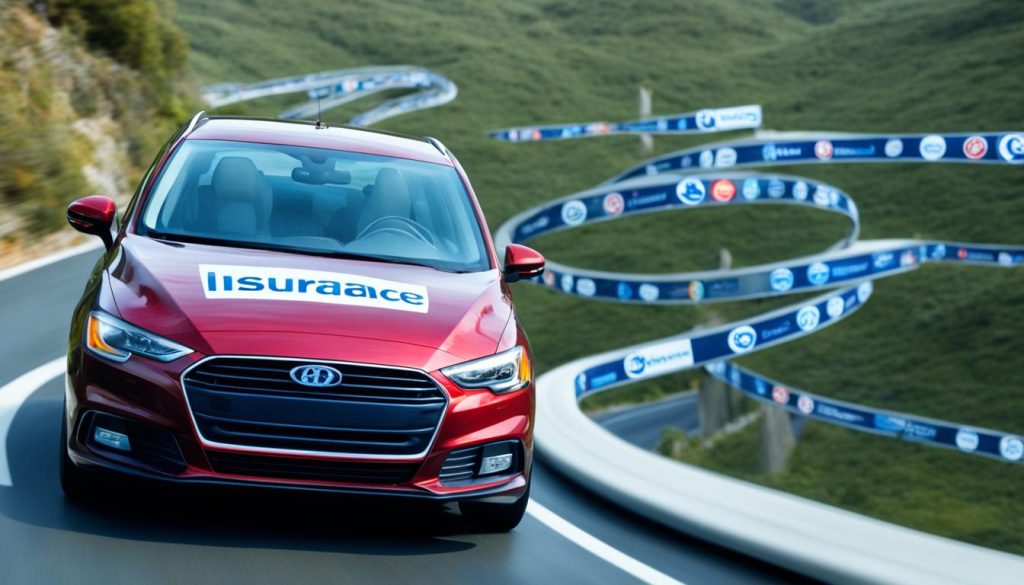Switching your auto insurance is easy but important. Make sure your new policy has the same or better coverages, limits, and deductibles as your old one. You might get lower rates with a new insurer, but check their customer service, claims handling, and financial strength first. This ensures they meet your needs. Always cancel your old policy correctly to avoid coverage gaps1.
Key Takeaways
- Switching auto insurance providers is a simple process, but ensure new coverage matches or exceeds your existing policy.
- Research the new insurer’s customer service, claims handling, and financial stability to ensure it meets your needs.
- Cancel your previous auto insurance policy properly to avoid coverage gaps when switching providers.
- Comparing quotes from multiple insurers can help you find the best rate and coverage options.
- Periodically reviewing your auto insurance needs can help you identify potential savings when switching providers.
Why Switch Car Insurance Providers?
Lower Rates and Better Coverage Options
Switching your car insurance provider can save you money and give you better coverage. Car insurance costs went up by 20.6% from January 2023 to January 2024, says the Bureau of Labor Statistics2. Also, people are less happy with their auto insurers, with a big drop in the J.D. Power 2023 U.S. Auto Insurance Study2. Bad customer service is a big reason for this2.
Life events like moving or getting a new car might have raised your rates. Looking at other providers could lead to a lower premium without losing coverage3. Some companies offer better policy options or discounts that suit your needs, making a switch a good idea.
For young drivers, car insurance is very expensive, especially for teens2. Changing to a provider with lower rates for young drivers could save you a lot. Changes in how you drive, like working from home, might make you want cheaper insurance. Looking into other companies could help you find better rates2.
| Insurer | Average Full Coverage Rate | Average Minimum Coverage Rate |
|---|---|---|
| State Farm | $883 per year | $591 per year |
| GEICO | $973 per year | $698 per year |
| Progressive | $1,042 per year | $706 per year |
| Allstate | $1,244 per year | $795 per year |
MoneyGeek looked at over 900,000 quotes from 64 companies and found State Farm has the cheapest full coverage at $883 per year on average3. But, car insurance costs change a lot based on your driving record, coverage, and even your credit score3. Switching providers could help you find cheaper rates and better coverage that fits your needs234.
How to Switch Auto Insurance Providers:
Switching your auto insurance provider can be easy if you plan well. Start by looking at quotes from different insurers to find the best deal5. You could save a lot of money by switching, possibly hundreds or even thousands of dollars6. Policies usually last six or twelve months. You might switch for reasons like saving money, not being happy with your current service, or moving.
When looking at new providers, think about customer service, how they handle claims, and their financial health7. Sites like A.M. Best or Standard & Poor’s can show you how stable an insurer is. The J.D. Power Auto Insurance Satisfaction Study can tell you how happy customers are. For instance, California’s Wawanesa was top-rated in 2020, while Texas Farm Bureau was No. 11.
- After picking a new policy, set a start date to avoid any gaps in coverage6. When you decide to switch, tell your current insurer and ask about any refunds you might get.
- Contact your current insurer to cancel your policy, but watch out for cancellation fees6. Switching during your policy might mean extra fees or penalties.
- Don’t forget to tell your lender or leasing company about your new insurance5. Avoid switching if you’re too busy, don’t want a gap in coverage, or are happy with your current rates and service.
Switching auto insurance can be a good choice if you want better coverage, lower rates, or better service5. Some insurers offer special coverage, like for classic cars, which might mean you need to switch6. Always look at different policies to find the best one at a good price.

Deciding to switch auto insurance should be based on what you need and like7. Think about whether you like working with your current insurer or if they don’t offer what you need to switch.
Timing Your Car Insurance Switch
The best time to switch car insurance is usually at the end of your current policy. This avoids cancellation fees or penalties8 that some companies charge. Some companies offer a discount if you request a quote before your new policy starts8.
You don’t have to wait for the policy to end to change insurers. You can switch at any time. Just make sure your new coverage starts the day after your old one ends to avoid a gap3. Switching during an open claim can also affect your rates.
Some factors can affect when it’s best to switch car insurance. For example, married drivers often pay less than unmarried ones8. Rates also change by state, so shopping around when moving is smart8. Loyalty benefits from your current insurer can save you money over time8.
Switching cars often can make it harder to get the best rates8. Some companies offer discounts to customers who stay with them for years8.
In summary, switching car insurance is best at the end of your term, but you can do it anytime without gaps3. Think about your marital status, location, and loyalty benefits to find the best time to switch834.
Evaluating New Auto Insurance Options
Comparing Quotes and Coverages
When looking for new auto insurance, it’s key to compare quotes from several providers. Make sure to check the coverage levels, deductibles, and discounts they offer9. Think about what you need now and in the future, like the car you drive, your driving record, and any loans or leases9. Find insurers that offer what you need at a good price. Don’t forget to ask about special deals or loyalty discounts9. Taking your time to look at all your options can help you find the best policy for you.
- Look at quotes from at least three car insurance companies to see what they offer10.
- Use discounts when you can, like for good grades, anti-theft devices, or bundling policies10.
- Think about how your credit score affects your rates and check out usage-based insurance for savings10.
- Use an independent agent or broker to find a good and affordable provider, especially for smaller companies10.
It’s important to know about the industry and what customers say when looking at auto insurance9. The J.D. Power studies give insights into customer service, claims, and financial strength of insurers9. Also, full-coverage car insurance offers more protection but costs more than the minimum.9
| Coverage Type | Description | Potential Cost |
|---|---|---|
| Liability Insurance | Covers damages and injuries to others if you’re at fault | Lower premiums |
| Collision Coverage | Covers damage to your car if you hit something else | Higher premiums |
| Comprehensive Insurance | Covers damage from theft, vandalism, or natural disasters | Higher premiums |
The best auto insurance for you will vary based on your needs and situation9. Things like getting married, buying a new car, or moving can change your rates and make you look for new options10. By comparing quotes and coverage from different providers, you can make a smart choice and find the right insurance for you.

“Choosing less car insurance can save money but might mean paying more out-of-pocket after an accident.”9
It’s a good idea to check your auto insurance every year to make sure you’re getting a good deal and enough protection11. By staying active and comparing options, you can find a balance between cost and coverage that fits your needs.
Conclusion
Switching car insurance providers can be easy if you plan and research well. Start by comparing quotes from different insurers12. Look at the coverage options and know about any fees or penalties. This way, you can find a policy that fits your needs and budget.
Many people switch because of rising rates13. But it’s not just about the cost. Customer service, extra features, and personal choices also matter13. An independent agent or broker can help you compare options and find the best deal13.
When you decide to switch, think about the timing. You might need to change providers before your current policy renews if rates go up a lot or if your life changes14. Make sure to cancel your old policy and tell anyone who needs to know, like your lender or leasing company. With some effort and the right info, you can find great car insurance that protects you without breaking the bank.
FAQ
What should I consider when switching car insurance providers?
Switching car insurance providers means making sure your new policy is as good or better than your old one. Look for lower rates, but also check the company’s customer service and financial strength. Always cancel your old policy correctly to avoid coverage gaps.
Why might someone want to switch car insurance providers?
People switch car insurance for cheaper rates or better coverage. Life events like moving or getting a new car might raise your rates. Shopping around can lead to a lower premium without losing coverage. Some insurers offer more options or discounts that suit your needs.
How do I switch car insurance providers?
Start by comparing quotes from different insurers. Look at customer service, claims handling, and financial health. Pick a new policy and set a start date to avoid coverage gaps. Then, cancel your old policy and update your lender or leasing company with your new info.
What is the best time to switch car insurance providers?
Switching at the end of your policy term is best to avoid fees. You can switch anytime, but make sure your new policy starts the day after your old one ends. Don’t switch during a claim, as it can raise your rates later.
What should I consider when researching new auto insurance options?
Compare quotes from several insurers and check coverage, deductibles, and discounts. Think about your driving habits, vehicle type, and any loan or lease requirements. Look for the best price and coverage for your needs. Negotiate or ask about special offers to get the best deal.
Source Links
- Switch Your Car Insurance in 8 Easy Steps | Bankrate
- 5 Reasons to Switch Your Car Insurance – Experian
- How to Switch Car Insurance
- How To Switch Car Insurance (4 Steps)
- How to Switch Your Auto Insurance
- A Step-by-Step Guide to Switch Car Insurance Providers
- When Should You Change Auto Insurance Providers?
- How to Switch Car Insurance Companies – QuoteWizard
- How To Switch Car Insurance
- How to Switch Car Insurance in 7 Easy Steps
- Switch Car Insurance Companies in 6 Steps – NerdWallet
- How To Switch Car Insurance – 2024 Guide
- 5 Reasons People Change Auto Insurance Carriers
- Is Now A Good Time To Switch Car Insurance Companies?

